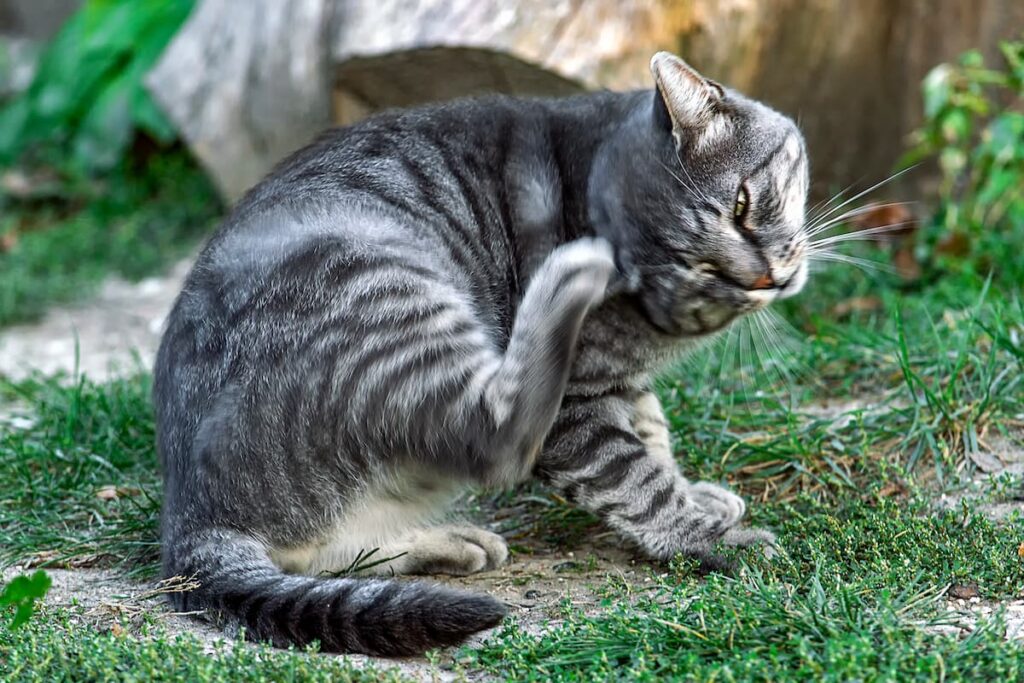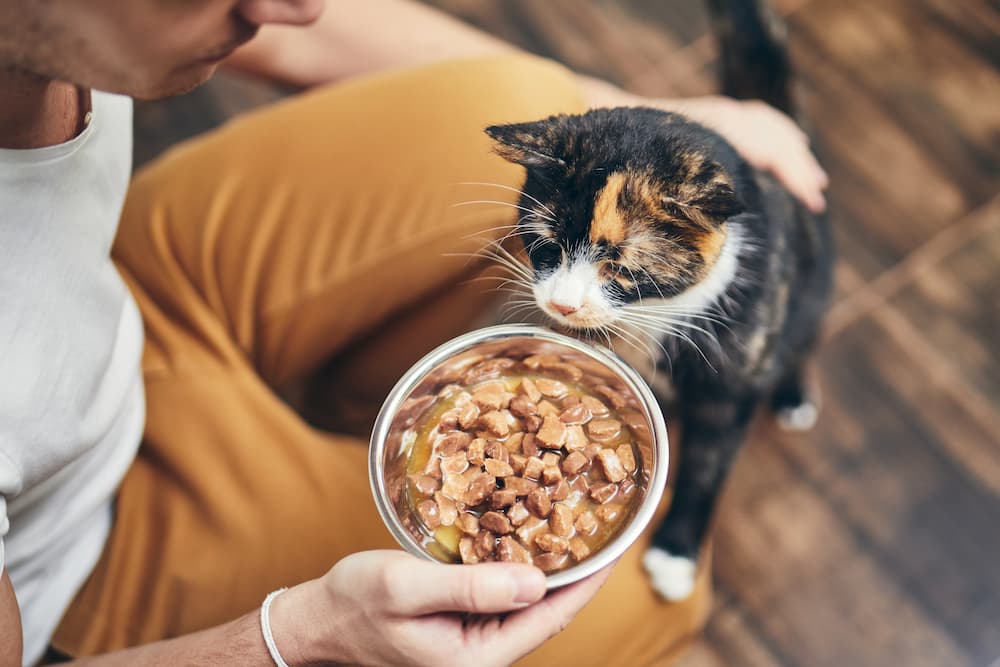Your cat’s skin is more impressive than you realise. Have you ever looked at their sagging belly and wondered whether to reduce food portions? Turns out this “belly” is actually excess skin called the primordial pouch, which serves several important functions, like allowing for greater flexibility during running and jumping.
You might not realise it but the skin is a crucial organ for cats so keeping it healthy is central to your cat’s wellbeing. One way to do this is by maintaining a healthy diet and checking for any food allergies and intolerances.
Designing a personalised cat allergy diet plan for your fur baby can address specific health needs by incorporating foods that target those issues. In this article, we’ll explain how you can utilise Pet Chemist products to keep your cat’s skin healthy as we learn more about this amazing organ.
The link between diet and skin health in cats
Like humans, cats can experience food allergies and intolerances that cause discomfort to the skin through itchiness, rashes, hair loss or infections. While some symptoms can be attributed to environmental factors like fleas or a change of season, others can develop based on your cat’s diet.
When we talk about food allergies and intolerances, we often group them together under the umbrella term “adverse food reactions,” but there are significant differences between the two. Food allergies occur when your cat’s immune system reacts to a certain ingredient and tries to eliminate it. Allergies can be serious and even life-threatening in some cases.
But here’s the good news. Most cats don’t have true allergies. Instead, they have a food intolerance, which doesn’t affect the immune system. It is more likely a result of poor digestion. While intolerances may be uncomfortable, they don’t pose a significant risk to your pet and can be easily managed with the right cat allergy diet.
Grains like corn and wheat, along with common protein sources like beef and chicken, can trigger an adverse reaction. Dairy and preservatives can also trigger a reaction, and it’s not always easy to identify which particular ingredient is the culprit.

Symptoms of cat allergies
Common symptoms of adverse food reactions include skin irritation, which will often cause a cat to over groom specific areas of the body, resulting in fur loss or bald patches. Cats may also experience regular skin and ear infections. But these aren’t the only symptoms of adverse food reactions. Other common signs include:
- Vomiting and diarrhoea
- Excessive gas or bowel movements
- Fungal or bacterial infections
- Inflammation or redness of the skin
- Dry or flaky skin
- Abrasions or sores on the skin (often linked to overgrooming)
- Swollen or inflamed lumps on the skin
- Scooting (caused by itchiness of the rectum)
Common food allergens for cats
Some of the most likely foods to cause adverse reactions in cats are chicken, beef, and fish, which are, unfortunately, the most common ingredients in feline food. Still, cats can experience reactions to several other ingredients such as dairy, egg, lamb, rabbit, and grains such as wheat and corn.
While artificially enhanced foods may look appealing, the additives can also be a risk factor for adverse reactions. And preservatives in processed foods can also pose a problem.
How can I tackle food allergies and skin issues?
Fortunately, there are several ways that you can adapt your cat’s diet to eliminate these issues. Before we explore them, remember that when making any changes to your cat’s diet, it is crucial to consult a vet, Additionally prescription foods require you to take the following steps:
- Visit a vet for your pet’s examination to ensure that there are no underlying causes for its skin or wider health issues. Only use prescription foods following a consultation with a professional.
- Attend checkups every six months so your vet can monitor the progress of your cat’s health.
- If your cat’s condition worsens with the dietary change, consult your vet immediately.
Cats with adverse food reactions can benefit from hypoallergenic or limited-ingredient cat allergy diets. Plus, if you cannot identify which specific food(s) are a problem, reducing the amount of ingredients might help narrow it down.
Pet Chemist offers a variety of foods to aid in improving your cat’s skin and coat quality, including limited ingredient nutrition and a single protein source. So, let’s explore exactly what you should be looking for when choosing the right food for your feline.
What am I looking for when choosing cat allergy diet food?
Now, the question is, how can we adapt your cat’s diet to help improve any adverse reactions they are experiencing? The answer is to look for high-quality ingredients in the foods you purchase. Still, this is no easy feat when you’re faced with a lengthy food label, so here are some key things to look out for:
Avoid too much grain
When we talk about grains, we are talking about ingredients like wheat and corn. Many quality foods contain small amounts of these ingredients, but you’ll want to avoid foods that have excessive amounts.
How can you tell? Take a look at the ingredients list. In a quality pet food, the protein source should be listed first. This means that protein is the primary ingredient. If you see wheat or corn as the primary ingredient, it could mean your cat is getting an excessive amount of carbohydrates.
The other thing to consider is that grains can cause reactions even in small amounts, but one specific grain could be the problem. Check your cat’s food label; if wheat is the carbohydrate source, try selecting where the source is: rice, soya or lentils.
Avoid foods that are heavy in artificial colours and preservatives
When you read a food label, there’ll often be an ingredient or two you’ve never heard of. However, you want to avoid products that have too many preservatives and artificial colours, such as Red 40 or Yellow 5, which are used purely for aesthetics and can cause unwanted reactions.
Additionally, there are common guidelines for foods you should and should not feed your cat.
Look for foods that contain key ingredients
When examining a food label, look for key ingredients that aid healthy skin and digestion. These include omega-3 and omega-6 fatty acids, which promote healthy skin and shiny coat while helping to reduce inflammation.
Added vitamins are good for your cat’s overall health. Zinc and Vitamin E work particularly well in caring for your cat’s skin and keeping it healthy. Probiotics can improve your cat’s gut health and immunity, reducing its sensitivity to certain foods.
How to choose the best cat food
We’ve discussed ways to look for healthy cat foods, so let’s implement those tips.
Take a look at the ingredients list for this hair and skin care food for adult cats. The list of ingredients is clear and straightforward. The main components are meat, fish, and vegetable proteins. The nutritional additives are healthy vitamins that we recognise, and there isn’t any excess filler.
You can also look for cat foods that promote probiotics to support digestive and immune health. Some, like Purina’s Pro plan, also include prebiotics that can help promote healthy gut microflora. These products are specifically formulated to induce digestible foods while eliminating artificial colours, flavours, and preservatives.
As previously mentioned – any changes you make to your feline’s diet should be approved by your vet, who can help you wean them into their new cat allergy diet. Your vet can also recommend the best option for your cat, which could include a prescription diet plan.
Don’t let adverse food reactions dull your cat’s shine. Check for symptoms, consult your vet, and shop Pet Chemist’s trusted range of high-quality skin care foods.
